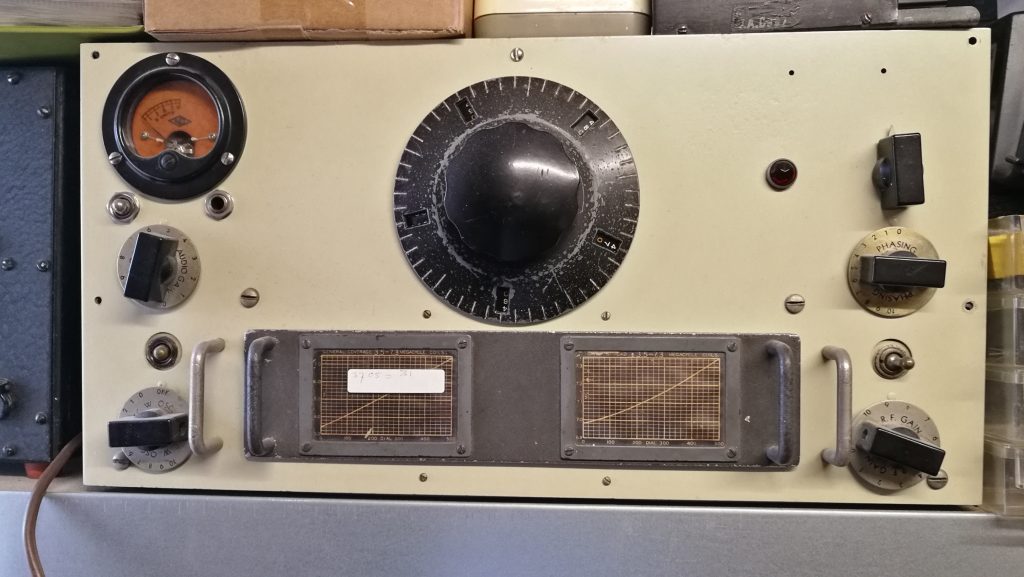Links:
http://www.radioblvd.com/National%20HRO.htm
under construction

In July 2010 I obtained a National HRO receiver, type M. The M-type was widely used in the Y-service (Wireless Intercept, short: WI, pronounced as: Y) of the British Secret Service.
At the height of activities there were between 1700 and 2000 Y-stations all over the country operating and in many the HRO were used as being the most sensitive and the most selective receiver on the market. Mind you, a Y-station could used 2 or 4 HRO’s, as the operators had to try to copy messages from as well the sending as the receiving party. So many, many HRO’s were used.
There has been written much about this great receiver already and I am not going to repeat that. Follow the links on top of this page if you want to read and see more. Here I tell you just about the one I obtained.
I picked it up and it was not used for a long time. The former owner did not know if it was in a working state. There were 6 coil sets and they looked bad. They aluminium of the coil housings was damaged by water, like it was rotten away. They had even little holes in them and white corrosion powder was stuck on it. The set of coils was not complete because 2 were the same, so 1 was missing as there are 7 in a complete set. It came with an original user manual, though this was in bad shape also.
Most pre war time and war time HRO’s are spray painted with the well known black crinkle paint. Some HRO’s were grey. The one I have, was painted by one previous owner. The front panel was sanded and sprayed in a yellow primer. Traces of the crinkle paint structure were visible through the yellow primer. The cabinet was grey, smooth, without traces of crinkled paint. I have to find out by the serial number what colour it should be: grey or crinkle-black.
Inspecting the interior learned that it looked very well. I suspect that one of the previous owners had rebuild and rewired the set. On one hand that is a pity, because we like our equipment to be in original status, on the other hand: the man did a good job, the rebuild was performed very professional. After firing up the set it turned out to work fine. That is: on the few coil sets that worked.
So I had to take the coil set apart to see why they did not work. Because three did work, I concluded that the set was all right and the problems were caused by the coil sets. I found corroded contacts. I found cold soldering joints. I found corrosion and dirt between the capacitor plates. And after fixing that, some coil sets still did not want to function. Measuring learned that capacitors were OK, that variable capacitors were OK and not shorted, that coil windings were not broken. And still they did not work. Finally I discovered the problem: the coil sets were treated badly and the housings were dented. Because of that, the contacts on top of the cans were not in line and simply did not make contact inside the coil set bay. One cannot see that happen inside the radio. Now comes the tedious job to make a wooden dowel that fits tight inside the cans. The idea is to press the dowel inside the can to restore the original shape, so the contacts are in line, again.
The receiver, itself, is not completely 100 % functional. The following problems must be solved:
- The S-meter is not working properly;
- The potentiometer RF-Gain is not operating smoothly as one would expect;
- The missing coil sets have to be obtained;
- The not functioning coil sets have to be restored;
- The set has to be repainted in its original colour;
- A set of spare tubes has to be obtained;
- A calibration booklet has to be made.
Wish list:
- A complete set of coil sets;
- An original loudspeaker;
- An original power supply;
- An original coil set cabinet.
The HRO is a receiver that uses a really clever dial. It is a mechanical construction, made with only two die-cast parts. It results in a scale with more than 500 divisions. Impressive, but unusable for amateurs, because there is no reference to the actual frequency one receives. The only references were little graphs on the front of the coil sets that translated dial setting to frequency. Very crude! Therefore, all HRO’s came with a calibration book. This booklet was tailor made for a particular set: radio and coil sets. No need to tell you that almost nobody has a surplus HRO with an original calibration booklet. Through the glorious Internet I came to a copy of such a booklet and that helps to find ones way around. It is not 100 % correct to my scale, but for the time being, useful. Another problem with this dial is to get it properly aligned, if one had taken it from the chassis. Here is a link to a document that explains how to do it.
The hunt for coil sets.
To be continued
